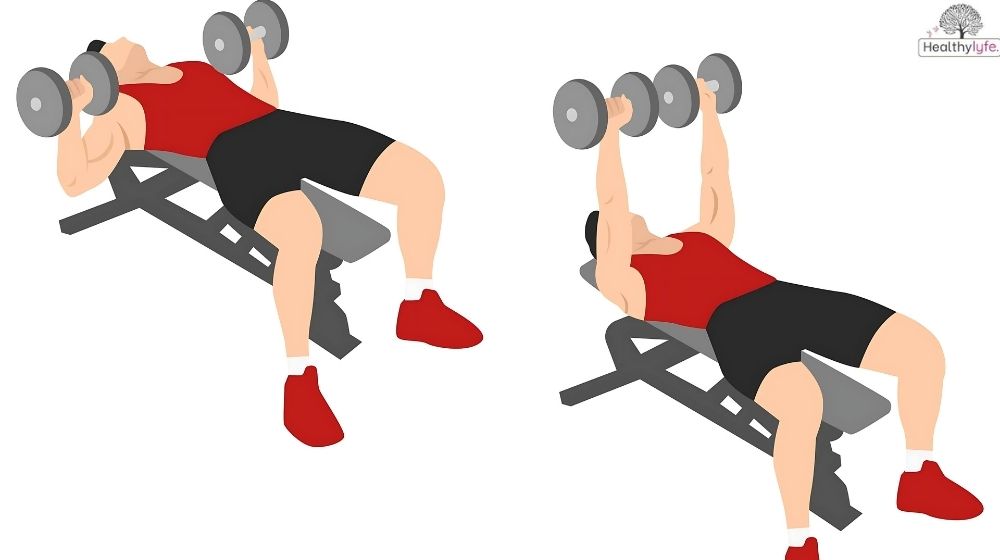Boost your back and upper body strength with the Dumbbell Row. Improve posture, build muscle, and increase overall strength with this effective exercise.
Introduction
The Dumbbell Row is a powerful strength training exercise that primarily targets the muscles of the back, including the lats, traps, and rhomboids, while also engaging the biceps, shoulders, and core. As a compound movement, the Dumbbell Row helps improve upper body strength, posture, and muscle definition.
This exercise can be done with one or both dumbbells and offers the advantage of allowing for a full range of motion, which promotes balanced muscle development and flexibility. Whether you’re aiming to improve your posture, build a stronger back, or enhance overall upper body strength, the Dumbbell Row is a versatile and effective addition to your workout routine.
What is Dumbbell Row?

The Dumbbell Row is a popular strength training exercise that primarily targets the muscles of the back, including the latissimus dorsi (lats), trapezius (traps), and rhomboids. It also works the biceps, shoulders, and core for stability. This exercise involves pulling a dumbbell toward your torso while maintaining a bent-over position, typically supported by one knee on a bench or performed with both feet planted on the floor.
The Dumbbell Row is a versatile, effective movement for building upper body strength, improving posture, and enhancing overall muscle definition. It can be performed with one arm at a time (single-arm row) or with both arms simultaneously (double-arm row), making it adaptable to various fitness levels and goals.
Type of Dumbbell Row
The Dumbbell Row is a great exercise for strengthening your back and upper body. There are different types of Dumbbell Rows that target various muscles in your back, shoulders, and arms. Here’s a simple breakdown of the most common types:
Single-Arm Dumbbell Row
In the Single-Arm Dumbbell Row, you use one dumbbell at a time. One hand and knee are supported on a bench, while the other arm pulls the dumbbell toward your body. This helps correct muscle imbalances and strengthens one side of the body at a time.
Double-Arm Dumbbell Row
The Double-Arm Dumbbell Row is performed by using both dumbbells at once. You bend over at the hips and row both weights towards your torso. This variation helps you work both sides of your back simultaneously, promoting balanced muscle development.
Bent-Over Dumbbell Row
In this variation, you bend your body at the hips, keeping your back flat, and row the dumbbells toward your body. The Bent-Over Dumbbell Row targets the upper and middle back, including the lats, traps, and rhomboids.
Renegade Row
The Renegade Row is a combination of a Dumbbell Row and a plank. You start in a plank position and row one dumbbell while balancing with the other arm. This variation works your upper body, core, and stabilizing muscles.
Incline Dumbbell Row
For the Incline Dumbbell Row, you lay face down on an incline bench and row the dumbbells upward. This version takes pressure off the lower back and helps focus more on the upper back muscles.
Chest-Supported Dumbbell Row
The Chest-Supported Dumbbell Row is done on a bench that supports your chest, allowing you to focus purely on your back muscles. This variation reduces strain on the lower back and targets the upper back more directly.
Benefits of Dumbbell Row [1]
The Dumbbell Row is an effective exercise for strengthening the upper body, especially the back, shoulders, and arms. It engages multiple muscle groups, making it a key move for overall fitness. Here are the main benefits of the Dumbbell Row:
Builds a Stronger Back
The Dumbbell Row targets the back muscles, including the lats, traps, and rhomboids. Regular practice helps build strength and muscle definition in the back, improving both appearance and performance.
Improves Posture
A strong back supports good posture. By strengthening upper back muscles, the Dumbbell Row helps you maintain a better posture and reduce slouching. This can also help prevent neck and shoulder pain.
Enhances Upper Body Strength
This exercise works not just the back, but also the biceps, shoulders, and forearms. It’s great for improving overall upper body strength, which is helpful for everyday tasks like lifting, carrying, and pulling.
Corrects Muscle Imbalances
When performed one arm at a time, the Dumbbell Row helps correct muscle imbalances between the left and right sides of your body. This ensures that both sides develop equally and reduces the risk of injury.
Boosts Core Stability
Your core muscles (abs and lower back) are engaged during the Dumbbell Row to help stabilize your body. This improves core strength and stability, which is important for balance in daily life and other exercises.
Improves Grip Strength
Holding the dumbbells during the row strengthens your grip. This can help with other exercises, such as deadlifts, and daily tasks that require hand strength.
Supports Functional Fitness
The Dumbbell Row mimics real-life movements, such as pulling objects toward you. This makes it a functional exercise that improves strength and mobility for everyday tasks.
Easy to Adjust
The Dumbbell Row is versatile and can be easily adjusted for your fitness level. You can change the weight, number of reps, or set variations to match your goals, whether you are a beginner or advanced lifter.
Prevents Injury
Strengthening your back helps protect your spine and prevent injuries, especially in the lower back area, which is often prone to strain.
Diet Plan for Dumbbell Row
To maximize the benefits of the Dumbbell Row and enhance your overall performance, it’s important to fuel your body with the right nutrients. A balanced diet that includes protein for muscle recovery, carbs for energy, and healthy fats for joint health is essential. Below is a simple diet plan to support your strength training, including the Dumbbell Row, to help you build muscle, improve recovery, and maintain optimal energy levels.
| Meal | Foods | Purpose/Benefits |
|---|---|---|
| Breakfast | Scrambled eggs, whole-grain toast, avocado, and a banana | High in protein for muscle repair, healthy fats for energy, and complex carbs for sustained fuel. |
| Mid-Morning Snack | Greek yogurt with berries and almonds | Protein for muscle maintenance and healthy fats for long-lasting energy. |
| Lunch | Grilled chicken breast, brown rice, steamed broccoli | Lean protein for muscle growth, complex carbs for energy, and fiber for digestion. |
| Afternoon Snack | Apple with peanut butter | Carbs for quick energy, healthy fats for sustained fuel, and protein to support muscles. |
| Pre-Workout | Oats with almond butter and chia seeds | Provides slow-releasing carbs for energy and healthy fats to fuel your workout. |
| Post-Workout | Protein shake (whey or plant-based), banana | Fast-digesting protein for muscle recovery and carbs to replenish energy stores. |
| Dinner | Salmon, quinoa, and steamed asparagus | Omega-3s for joint health, protein for muscle repair, and complex carbs for recovery. |
| Evening Snack | Cottage cheese with sliced pineapple | Slow-digesting protein to support muscle repair overnight. |
Key Considerations:
- Protein: Essential for muscle growth and repair. Aim for 1.2 to 2.0 grams of protein per kilogram of body weight.
- Carbohydrates: Needed for energy, especially around your workouts. Focus on complex carbs like oats, brown rice, and sweet potatoes.
- Fats: Healthy fats, such as those from avocado, nuts, and olive oil, are important for hormone regulation and joint health.
- Hydration: Drink plenty of water throughout the day, especially before, during, and after workouts, to stay hydrated and support muscle function.
Tips for Dumbbell Row Exercise
The Dumbbell Row is an excellent exercise for strengthening the back, shoulders, and arms. To get the best results and avoid injury, it’s important to perform the exercise with proper technique. Here are some essential tips to help you perform the Dumbbell Row correctly, making sure you maximize your gains while staying safe.

Keep Your Back Neutral
Make sure your back stays flat and neutral during the Dumbbell Row. Avoid rounding or arching your back. A neutral spine protects your lower back and helps you engage your core, giving you better stability and control during the exercise.
Engage Your Core
Before starting the movement, tighten your core muscles. Engaging your core will help keep your body stable and prevent strain on your back while you row the dumbbells. A strong core supports your posture and balance throughout the exercise.
Pull with Your Back, Not Your Arms
Focus on using your back muscles to pull the dumbbells toward your body. Initiate the movement by squeezing your shoulder blades together. This ensures that the exercise targets the right muscles, such as the lats and traps, rather than overworking your biceps.
Keep Elbows Close to Your Body
When you row the dumbbells, keep your elbows close to your sides. Avoid letting them flare out. This helps you maintain proper form, reduces shoulder strain, and ensures that you’re using your back muscles effectively.
Use a Full Range of Motion
Ensure that you’re pulling the dumbbells all the way towards your torso and lowering them fully. A full range of motion helps you work your muscles properly and promotes muscle growth and flexibility.
Avoid Using Momentum
Don’t rely on swinging or jerking the dumbbells. Perform each rep slowly and with control. Using momentum takes the focus away from the target muscles and can lead to injury. Slow, controlled movements help you build strength more effectively.
Start with Lighter Weights
If you’re new to the Dumbbell Row, start with lighter weights to master the form. Once you’re comfortable with the movement, gradually increase the weight to challenge your muscles further. Proper form should always come first, even as you increase the weight.
Focus on One Side at a Time (For Single-Arm Row)
When performing the Single-Arm Dumbbell Row, concentrate on one arm at a time. Keep your body stable and avoid twisting or jerking. This allows you to target each side of your back more effectively, leading to balanced muscle development.
Maintain Proper Neck Alignment
Keep your neck in line with your spine. Avoid looking up or down during the exercise, as this can strain your neck. Looking straight ahead or slightly down helps maintain proper posture and reduces the risk of injury.
Warm Up Before Starting
Before you begin any strength training exercises, including the Dumbbell Row, take time to warm up your muscles. Do dynamic stretches or light cardio to prepare your body, increase blood flow, and reduce the risk of injury.
Conclusion
The Dumbbell Row is a powerful exercise that helps strengthen the back, shoulders, and arms. It targets multiple muscle groups, improving posture, building upper body strength, and enhancing core stability. Whether you’re a beginner or an advanced lifter, adding the Dumbbell Row to your routine can help you achieve better muscle definition and functional fitness.
FAQs about Dumbbell Row Exercise
What muscles does the Standing Overhead Dumbbell Press work?
The primary muscles worked are the deltoids (shoulders), with secondary activation of the triceps, upper chest, traps, and core muscles for stabilization.
What is the correct form for a Standing Overhead Dumbbell Press?
Stand with feet shoulder-width apart, dumbbells at shoulder height with palms facing forward. Engage your core, press the dumbbells overhead until arms are fully extended, then lower them back to the starting position.
Should I use a neutral grip or palms-forward grip?
A neutral grip (palms facing each other) may reduce strain on the shoulders and wrists. A palms-forward grip emphasizes the deltoids more and is common in traditional pressing.
How much weight should I use?
Start with a weight that allows you to perform 8-12 reps with proper form. Gradually increase as you build strength.
How many sets and reps are recommended?
For strength: 4-6 sets of 4-6 reps
For hypertrophy: 3-4 sets of 8-12 reps
For endurance: 2-3 sets of 12-15 reps
How does it compare to the seated version?
The standing version engages the core and stabilizers more, while the seated version isolates the shoulders by reducing lower-body involvement.
Is the Standing Overhead Dumbbell Press safe for beginners?
Yes, if performed with proper form and light weights. Beginners should focus on technique and core stability.
What are common mistakes to avoid?
Overarching the back
Flaring elbows too wide
Using too much weight
Not fully engaging the core
Uneven pressing of the dumbbells
How can I improve my overhead press strength?
Incorporate accessory exercises like push presses, lateral raises, tricep dips, and core strengthening exercises. Gradual progressive overload also helps.
Can it help with building bigger shoulders?
Yes, it is an excellent compound exercise for shoulder hypertrophy when combined with proper diet and progressive overload.
Should I lock out my elbows at the top?
Locking out slightly can improve triceps activation but avoid hyperextending to prevent joint strain.
Does it help improve posture?
Yes, the exercise strengthens shoulder and upper back muscles, which can help correct poor posture when combined with stretching.
Can I perform it with one dumbbell at a time?
Yes, a unilateral overhead dumbbell press improves balance, reduces muscle imbalances, and engages the core more.
How can I avoid lower back pain during the press?
Engage your core, avoid overarching the lower back, and consider slightly bending your knees for additional stability.
What are good warm-ups for this exercise?
Warm-ups include shoulder circles, arm swings, lightweight presses, or banded exercises to prepare the joints and muscles.
Disclaimer: The information provided in this article is for general informational purposes only and is not intended as medical advice. Always consult with a healthcare professional or certified fitness trainer before starting any new exercise.
By healthylyfe


